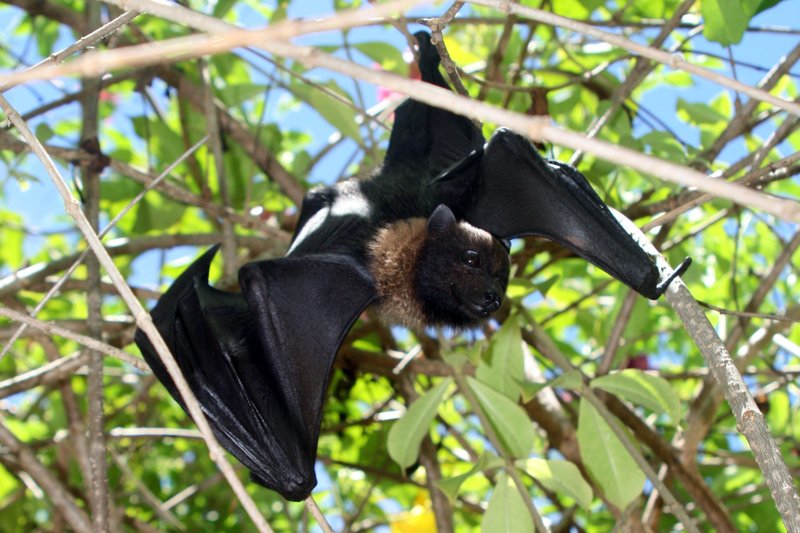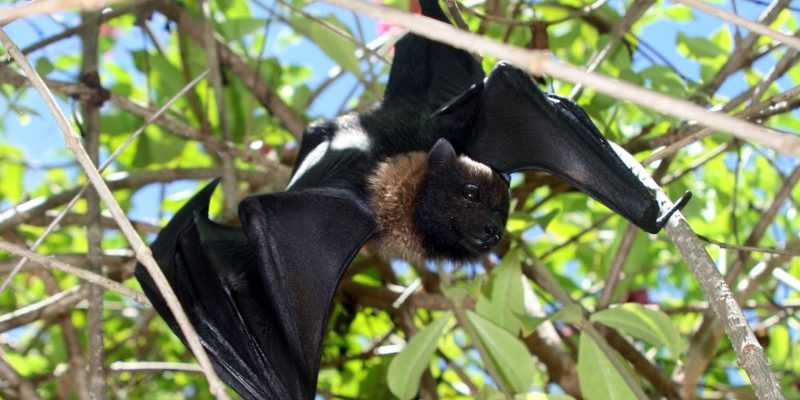
When you think of bats, you might picture creatures that swoop around at night with scary screeches. But, let’s flip that perception on its head! Enter the fruit bat, a gentle giant of the bat world that plays an essential role in our ecosystem. Imagine a fluffy flying fox, hanging out in the trees and munching on juicy fruits—sounds adorable, right? These incredible mammals are not just cute; they are critical for pollination and seed dispersal, helping many plants thrive.
Fruit bats, also known as flying foxes, are part of the Pteropodidae family. Unlike their insect-eating cousins, these bats are predominantly herbivorous, relying on fruits, nectar, and flowers for their diet. With big eyes and a keen sense of smell, they navigate through the night sky in search of their favorite snacks. Whether you find them in a tropical rainforest or a wild garden, these bats are fascinating creatures that often go unnoticed.
Physical Characteristics
Fruit bats are truly remarkable when it comes to their size and appearance. They can vary from small to impressively large, with some species boasting wingspans that can reach up to 6 feet! Their fur is often soft and fluffy, providing insulation against the climate. In fact, their colors range from rich browns to striking blacks, sometimes even sporting a hint of orange or golden hues on their bodies.
For instance, the Giant Golden-Crowned Flying Fox of the Philippines is one of the largest fruit bats, weighing up to 3.5 pounds. On the other hand, the small Little Red Flying Fox, which can weigh as little as 1.5 pounds, is perfect for navigating through dense forests. Their large eyes help them see in low light, and their sense of smell is finely tuned to detect ripe fruits from afar.
In summary, these creatures are not just about size. They possess long, flexible tongues that enable them to reach deep into flowers to sip nectar, while their strong jaws help them tear through tough fruits. Fruit bats are a showcase of evolutionary adaptation that lets them thrive in their environments.
Habitat and Distribution
Fruit bats are primarily found in tropical and subtropical regions around the world. You’ll often see them in places like rainforests, mangroves, and even urban areas where fruiting trees abound. They prefer locations that offer plenty of food sources and roosting sites, like tall trees or caves. Interestingly, their roosting habits can sometimes cause a stir as they gather in large colonies, sometimes numbering in the thousands!
Geographically, these bats are spread across Africa, Asia, Australia, and certain islands of the Pacific. For instance, the Grey-Headed Flying Fox can be found in Australia, while the Large Fruit Bat resides in the rainforests of Africa. Their habitats are crucial not just for the bats but for the plants and wildlife that rely on their pollination services.
However, these habitats are under threat due to deforestation and urbanization. As humans encroach on their spaces, it’s vital to conserve these natural environments to ensure fruit bats can continue to perform their essential ecological roles.
Diet and Feeding Habits
Fruit bats have a diet that might make you feel hungry just thinking about it! They primarily feast on a variety of fruits, such as bananas, mangoes, and figs. In addition to fruits, they enjoy sipping on nectar and can also consume pollen and flowers. This plant-based diet positions them as key players in their ecosystems, contributing to seed dispersal and plant pollination.
What’s incredible is how they find their food. While they have excellent vision, it’s their sense of smell that truly guides them. They can detect the scent of ripe fruit from impressive distances, making them adept foragers. When they find a tasty fruit, they often hang upside down while they eat—quite the spectacle if you’ve never seen it!
Interestingly, fruit bats can also play a role in their community by helping plants regenerate. After consuming fruits, they disperse seeds in their droppings, which can lead to new plant growth far from the parent plant. This mutual benefit highlights how intertwined their survival is with that of many plant species.
Reproduction and Lifespan
In the world of fruit bats, reproduction is a fascinating process. Most species engage in a mating ritual that often involves vocalizations and displays. After mating, a female bat typically gives birth to a single pup. This occurs once a year, aligning with the peak fruiting seasons in their habitats, which helps ensure that both mother and pup have plenty to eat.
Once born, the pup clings to its mother’s belly, relying on her for nourishment and warmth. Interestingly, young fruit bats can’t fly right away. They begin to learn how to soar by hanging out alongside their mothers, practicing flapping their wings until they gain the confidence to take flight.
As for their lifespan, fruit bats can live surprisingly long! Depending on the species, they can live anywhere from 10 to 30 years in the wild. Some even have been known to reach upwards of 40 years in captivity, mainly due to the lack of predators and consistent access to food. This long lifespan allows them to contribute many years to pollination and seed dispersion, which is vital for their ecological roles.
Conservation Status
Unfortunately, fruit bats face numerous threats in the wild. Habitat loss due to deforestation, hunting, and climate change have severely impacted their populations. For instance, the Pacific Flying Fox is listed as vulnerable due to significant habitat decline. In some regions, they are hunted for food or their wings are used in traditional medicine—a practice that raises concerns about their survival.
Conservation efforts are underway in many places to protect these important creatures. Organizations focus on habitat preservation and raising awareness about the ecological roles these bats play. By creating protected areas and promoting sustainable practices, we can help ensure that fruit bats have a future.
Additionally, educational programs play a key role in changing perceptions about bats. Many people associate bats with disease or danger, but fostering a better understanding of their importance can lead to better community support for conservation efforts. The more we know about them, the more we can appreciate their role in keeping our ecosystems balanced!
| Species | Wingspan | Diet | Lifespan | Habitat |
| Giant Golden-Crowned Flying Fox | Up to 6 feet | Fruits and nectar | Up to 30 years | Tropical rainforests |
| Little Red Flying Fox | Up to 3 feet | Fruits and nectar | Up to 20 years | Woodlands and forests |
| Grey-Headed Flying Fox | Up to 4.5 feet | Fruits | Up to 12 years | Temperate forests |
FAQ
What do fruit bats eat?
Fruit bats primarily enjoy a diet of fruits, nectar, and flowers. They feast on a variety of fruits, including bananas, mangoes, and figs. Their ability to detect ripe fruit through their keen sense of smell makes them skilled foragers. Additionally, they can be seen gulping down nectar from flowers, contributing to the pollination of many plant species.
Are fruit bats harmful to humans?
No, fruit bats are not harmful to humans. They are generally peaceful creatures that avoid contact with people. In fact, they provide valuable services to the environment through pollination and seed dispersal. However, like all wild animals, they should be appreciated from a distance and not approached, as sudden interactions could stress them out.
Where do fruit bats roost?
Fruit bats typically roost in large colonies. They often choose tall trees, caves, or man-made structures for roosting purposes. These locations provide shelter from predators and offer proximity to their food sources. Sometimes, you might find them hanging out in clusters, which can be an amazing sight to behold.
How long do fruit bats live?
Fruit bats can have a surprisingly long lifespan, living anywhere from 10 to 30 years in the wild. In captivity, with adequate care, some species can exceed 40 years. Their longevity is crucial as it allows them to continue their important ecological roles throughout their lives.
Why are fruit bats important to the ecosystem?
Fruit bats play a vital role in maintaining healthy ecosystems. They are essential for pollinating many tropical plants and dispersing seeds across large areas. This helps promote plant diversity and regeneration, which is important for the overall health of their habitats. Without them, many plant species would struggle to thrive.
Are fruit bats social animals?
Yes, fruit bats are very social creatures! They often roost in large colonies, fostering social bonds within their groups. They communicate using various vocalizations and can often be seen grooming one another. These social interactions are crucial for their well-being and play a role in their reproductive success.
Do fruit bats hibernate?
Unlike some other bat species, fruit bats do not hibernate. Instead, they are active year-round. During the day, they rest in their roosts and become active at night to feed. Their foraging activities are closely tied to the availability of fruits in their environment, which keeps them active throughout the year.
What can I do to help fruit bats?
You can help fruit bats by supporting conservation efforts and protecting their habitats. Consider planting native trees that bear fruits or providing safe spaces for these bats to roost. Educating others about the importance of fruit bats and dispelling myths can also contribute to their protection. Every small effort counts in safeguarding these wonderful creatures!
What threats do fruit bats face?
Fruit bats face numerous threats, including habitat loss due to deforestation, hunting, and climate change. As humans encroach on their natural environments, their populations are at risk. Conservation organizations work to protect their habitats and promote sustainable practices to ensure the survival of these vital animals.
Are fruit bats nocturnal?
Yes, fruit bats are nocturnal creatures. They are primarily active during the night, which helps them avoid predation and take advantage of cooler temperatures. During the daytime, they roost in colonies, resting and socializing until it’s time to venture out for their nightly foraging. This nocturnal lifestyle is part of their unique adaptability to their environments.
Can fruit bats transmit diseases?
While fruit bats can carry diseases, the risk to humans is generally low if proper caution is exercised. It’s essential to avoid direct contact with wild bats and to respect their habitats. By understanding and appreciating these animals, we can coexist with them safely, allowing them to continue their important roles in our ecosystems.

